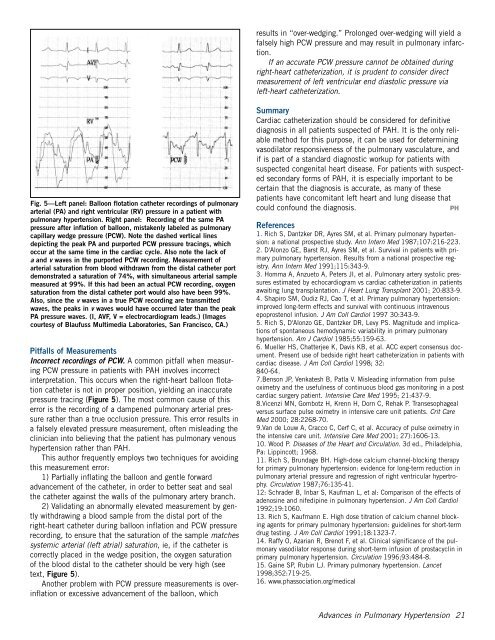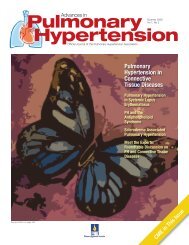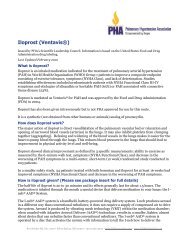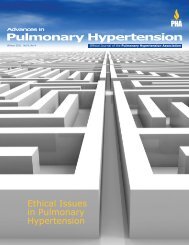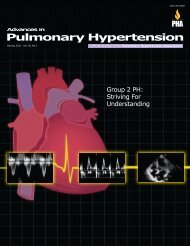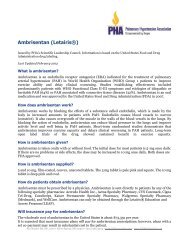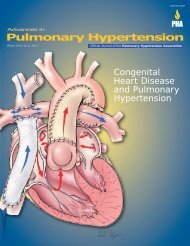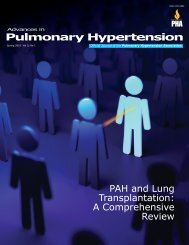Advances in Pulmonary Hypertension - PHA Online University
Advances in Pulmonary Hypertension - PHA Online University
Advances in Pulmonary Hypertension - PHA Online University
Create successful ePaper yourself
Turn your PDF publications into a flip-book with our unique Google optimized e-Paper software.
Fig. 5—Left panel: Balloon flotation catheter record<strong>in</strong>gs of pulmonary<br />
arterial (PA) and right ventricular (RV) pressure <strong>in</strong> a patient with<br />
pulmonary hypertension. Right panel: Record<strong>in</strong>g of the same PA<br />
pressure after <strong>in</strong>flation of balloon, mistakenly labeled as pulmonary<br />
capillary wedge pressure (PCW). Note the dashed vertical l<strong>in</strong>es<br />
depict<strong>in</strong>g the peak PA and purported PCW pressure trac<strong>in</strong>gs, which<br />
occur at the same time <strong>in</strong> the cardiac cycle. Also note the lack of<br />
a and v waves <strong>in</strong> the purported PCW record<strong>in</strong>g. Measurement of<br />
arterial saturation from blood withdrawn from the distal catheter port<br />
demonstrated a saturation of 74%, with simultaneous arterial sample<br />
measured at 99%. If this had been an actual PCW record<strong>in</strong>g, oxygen<br />
saturation from the distal catheter port would also have been 99%.<br />
Also, s<strong>in</strong>ce the v waves <strong>in</strong> a true PCW record<strong>in</strong>g are transmitted<br />
waves, the peaks <strong>in</strong> v waves would have occurred later than the peak<br />
PA pressure waves. (I, AVF, V = electrocardiogram leads.) (Images<br />
courtesy of Blaufuss Multimedia Laboratories, San Francisco, CA.)<br />
Pitfalls of Measurements<br />
Incorrect record<strong>in</strong>gs of PCW. A common pitfall when measur<strong>in</strong>g<br />
PCW pressure <strong>in</strong> patients with PAH <strong>in</strong>volves <strong>in</strong>correct<br />
<strong>in</strong>terpretation. This occurs when the right-heart balloon flotation<br />
catheter is not <strong>in</strong> proper position, yield<strong>in</strong>g an <strong>in</strong>accurate<br />
pressure trac<strong>in</strong>g (Figure 5). The most common cause of this<br />
error is the record<strong>in</strong>g of a dampened pulmonary arterial pressure<br />
rather than a true occlusion pressure. This error results <strong>in</strong><br />
a falsely elevated pressure measurement, often mislead<strong>in</strong>g the<br />
cl<strong>in</strong>ician <strong>in</strong>to believ<strong>in</strong>g that the patient has pulmonary venous<br />
hypertension rather than PAH.<br />
This author frequently employs two techniques for avoid<strong>in</strong>g<br />
this measurement error:<br />
1) Partially <strong>in</strong>flat<strong>in</strong>g the balloon and gentle forward<br />
advancement of the catheter, <strong>in</strong> order to better seat and seal<br />
the catheter aga<strong>in</strong>st the walls of the pulmonary artery branch.<br />
2) Validat<strong>in</strong>g an abnormally elevated measurement by gently<br />
withdraw<strong>in</strong>g a blood sample from the distal port of the<br />
right-heart catheter dur<strong>in</strong>g balloon <strong>in</strong>flation and PCW pressure<br />
record<strong>in</strong>g, to ensure that the saturation of the sample matches<br />
systemic arterial (left atrial) saturation, ie, if the catheter is<br />
correctly placed <strong>in</strong> the wedge position, the oxygen saturation<br />
of the blood distal to the catheter should be very high (see<br />
text, Figure 5).<br />
Another problem with PCW pressure measurements is over<strong>in</strong>flation<br />
or excessive advancement of the balloon, which<br />
results <strong>in</strong> “over-wedg<strong>in</strong>g.” Prolonged over-wedg<strong>in</strong>g will yield a<br />
falsely high PCW pressure and may result <strong>in</strong> pulmonary <strong>in</strong>farction.<br />
If an accurate PCW pressure cannot be obta<strong>in</strong>ed dur<strong>in</strong>g<br />
right-heart catheterization, it is prudent to consider direct<br />
measurement of left ventricular end diastolic pressure via<br />
left-heart catheterization.<br />
Summary<br />
Cardiac catheterization should be considered for def<strong>in</strong>itive<br />
diagnosis <strong>in</strong> all patients suspected of PAH. It is the only reliable<br />
method for this purpose, it can be used for determ<strong>in</strong><strong>in</strong>g<br />
vasodilator responsiveness of the pulmonary vasculature, and<br />
if is part of a standard diagnostic workup for patients with<br />
suspected congenital heart disease. For patients with suspected<br />
secondary forms of PAH, it is especially important to be<br />
certa<strong>in</strong> that the diagnosis is accurate, as many of these<br />
patients have concomitant left heart and lung disease that<br />
could confound the diagnosis. PH<br />
References<br />
1. Rich S, Dantzker DR, Ayres SM, et al. Primary pulmonary hypertension:<br />
a national prospective study. Ann Intern Med 1987;107:216-223.<br />
2. D'Alonzo GE, Barst RJ, Ayres SM, et al. Survival <strong>in</strong> patients with primary<br />
pulmonary hypertension. Results from a national prospective registry.<br />
Ann Intern Med 1991;115:343-9.<br />
3. Homma A, Anzueto A, Peters JI, et al. <strong>Pulmonary</strong> artery systolic pressures<br />
estimated by echocardiogram vs cardiac catheterization <strong>in</strong> patients<br />
await<strong>in</strong>g lung transplantation. J Heart Lung Transplant 2001; 20:833-9.<br />
4. Shapiro SM, Oudiz RJ, Cao T, et al. Primary pulmonary hypertension:<br />
improved long-term effects and survival with cont<strong>in</strong>uous <strong>in</strong>travenous<br />
epoprostenol <strong>in</strong>fusion. J Am Coll Cardiol 1997 30:343-9.<br />
5. Rich S, D'Alonzo GE, Dantzker DR, Levy PS. Magnitude and implications<br />
of spontaneous hemodynamic variability <strong>in</strong> primary pulmonary<br />
hypertension. Am J Cardiol 1985;55:159-63.<br />
6. Mueller HS, Chatterjee K, Davis KB, et al. ACC expert consensus document.<br />
Present use of bedside right heart catheterization <strong>in</strong> patients with<br />
cardiac disease. J Am Coll Cardiol 1998; 32:<br />
840-64.<br />
7.Benson JP, Venkatesh B, Patla V. Mislead<strong>in</strong>g <strong>in</strong>formation from pulse<br />
oximetry and the usefulness of cont<strong>in</strong>uous blood gas monitor<strong>in</strong>g <strong>in</strong> a post<br />
cardiac surgery patient. Intensive Care Med 1995; 21:437-9.<br />
8.Vicenzi MN, Gombotz H, Krenn H, Dorn C, Rehak P. Transesophageal<br />
versus surface pulse oximetry <strong>in</strong> <strong>in</strong>tensive care unit patients. Crit Care<br />
Med 2000; 28:2268-70.<br />
9.Van de Louw A, Cracco C, Cerf C, et al. Accuracy of pulse oximetry <strong>in</strong><br />
the <strong>in</strong>tensive care unit. Intensive Care Med 2001; 27):1606-13.<br />
10. Wood P. Diseases of the Heart and Circulation. 3d ed., Philadelphia,<br />
Pa: Lipp<strong>in</strong>cott; 1968.<br />
11. Rich S, Brundage BH. High-dose calcium channel-block<strong>in</strong>g therapy<br />
for primary pulmonary hypertension: evidence for long-term reduction <strong>in</strong><br />
pulmonary arterial pressure and regression of right ventricular hypertrophy.<br />
Circulation 1987;76:135-41.<br />
12: Schrader B, Inbar S, Kaufman L, et al: Comparison of the effects of<br />
adenos<strong>in</strong>e and nifedip<strong>in</strong>e <strong>in</strong> pulmonary hypertension. J Am Coll Cardiol<br />
1992;19:1060.<br />
13. Rich S, Kaufmann E. High dose titration of calcium channel block<strong>in</strong>g<br />
agents for primary pulmonary hypertension: guidel<strong>in</strong>es for short-term<br />
drug test<strong>in</strong>g. J Am Coll Cardiol 1991;18:1323-7.<br />
14. Raffy O, Azarian R, Brenot F, et al. Cl<strong>in</strong>ical significance of the pulmonary<br />
vasodilator response dur<strong>in</strong>g short-term <strong>in</strong>fusion of prostacycl<strong>in</strong> <strong>in</strong><br />
primary pulmonary hypertension. Circulation 1996;93:484-8.<br />
15. Ga<strong>in</strong>e SP, Rub<strong>in</strong> LJ. Primary pulmonary hypertension. Lancet<br />
1998;352:719-25.<br />
16. www.phassociation.org/medical<br />
<strong>Advances</strong> <strong>in</strong> <strong>Pulmonary</strong> <strong>Hypertension</strong> 21


